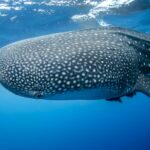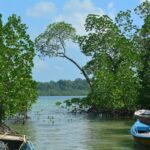Brief Overview of the Galapagos Islands
The Galapagos Islands, a volcanic archipelago located in the Pacific Ocean, is a fascinating spectacle of nature. Known for their rich biodiversity and unique species, these islands are a living testament to the evolutionary processes that have shaped life on Earth. But beyond their biological significance, the Galapagos Islands also hold a unique place in the field of geology.
Importance of the Galapagos Islands in Geology
The Galapagos Islands are not just an ecological marvel; they are also a geological enigma. Their location, formation, and continuous movement offer invaluable insights into the workings of our planet. They serve as a natural laboratory for studying plate tectonics, the geological theory that explains the structure and motion of Earth’s lithosphere.
The Science Behind the Movement of the Galapagos Islands
Understanding Plate Tectonics
Plate tectonics is the theory that Earth’s outer shell is divided into several plates that glide over the mantle, the rocky inner layer above the core. These plates move, collide, and diverge, causing earthquakes, volcanic activity, and the creation of mountain ranges and oceanic trenches.
The Role of the Nazca Plate in the Movement of the Galapagos Islands
The Galapagos Islands are located on the Nazca Plate, one of the major tectonic plates that make up Earth’s lithosphere. This plate is moving eastward towards the South American Plate at a rate of about 5 centimeters per year. This constant movement is a key factor in the geological evolution of the Galapagos Islands.
The Stationary Hot Spot and its Impact on Island Formation
Beneath the moving Nazca Plate is a stationary hot spot, a place where molten rock from the mantle rises to the surface. As the Nazca Plate moves over this hot spot, it creates a series of volcanic eruptions that form the Galapagos Islands. This process, known as hot spot volcanism, is responsible for the creation of many island chains around the world.
The Rate of Movement of the Galapagos Islands
Measuring the Movement of the Islands
The movement of the Galapagos Islands is measured using GPS technology. These measurements have shown that the islands are drifting eastward at a rate of about 5 centimeters per year. This might seem slow, but in geological terms, it’s quite fast.
Implications of the 5cm per Year Drift
The eastward drift of the Galapagos Islands has significant implications. As the islands move away from the hot spot, they gradually sink and erode, eventually disappearing beneath the ocean’s surface. Meanwhile, new islands are formed over the hot spot, ensuring the continued existence of the Galapagos archipelago.
The Formation of New Volcanoes and Islands
The Connection Between the Islands’ Movement and Volcanic Activity
The movement of the Galapagos Islands is closely linked to volcanic activity. As the Nazca Plate moves over the hot spot, magma rises to the surface, creating new volcanoes. These volcanoes eventually build up to form new islands.
How New Islands are Formed
New islands in the Galapagos archipelago are formed through a process of volcanic eruption and accumulation. Magma from the hot spot erupts through the ocean floor, creating a seamount. Over time, repeated eruptions cause the seamount to grow until it breaks the ocean surface, forming a new island.
The Impact of the Islands’ Movement on Biodiversity
Effects on the Unique Ecosystem of the Galapagos Islands
The movement of the Galapagos Islands has a profound impact on their unique ecosystems. As islands move away from the hot spot and begin to sink and erode, habitats change and species must adapt or perish. This dynamic process contributes to the extraordinary biodiversity and endemism found in the Galapagos.
Potential Threats to Endemic Species
While the movement of the Galapagos Islands drives evolution and speciation, it also poses threats to endemic species. As islands sink and erode, habitats are lost. Species that are unable to adapt or migrate may face extinction.
The Future of the Galapagos Islands
Predictions Based on Current Movement Rates
Based on current movement rates, geologists predict that the older eastern islands will eventually disappear beneath the ocean surface, while new islands will continue to form in the west. This ongoing process ensures the survival of the Galapagos archipelago, even as individual islands come and go.
Possible Consequences for the Islands and their Ecosystems
The continued movement of the Galapagos Islands will undoubtedly have consequences for their ecosystems. As islands sink and new ones form, species will have to adapt to changing habitats. This dynamic environment will continue to drive evolution and speciation, but it may also lead to the loss of some species.
The Galapagos Islands as a Case Study in Geology
What the Galapagos Islands Teach Us About Plate Tectonics
The Galapagos Islands provide a unique opportunity to study plate tectonics in action. Their movement, driven by the eastward drift of the Nazca Plate, offers a tangible example of how tectonic forces shape our planet. The formation of new islands over a stationary hot spot provides a clear illustration of hot spot volcanism.
Other Examples of Island Chains Formed by Moving Plates
The Galapagos Islands are not the only island chain formed by moving tectonic plates. The Hawaiian Islands, for example, were also created by a stationary hot spot beneath a moving plate. These and other examples reinforce the fundamental principles of plate tectonics and hot spot volcanism.
Conclusion
Recap of the Galapagos Islands’ Movement and its Implications
The movement of the Galapagos Islands, driven by the eastward drift of the Nazca Plate over a stationary hot spot, is a fascinating example of plate tectonics and hot spot volcanism. This process has shaped the islands’ unique landscapes and ecosystems, and will continue to do so in the future.
The Ongoing Importance of Studying the Galapagos Islands
The Galapagos Islands remain an important subject of study for geologists and biologists alike. Understanding their movement and evolution not only sheds light on the fundamental processes that shape our planet, but also helps us predict and prepare for the future. As we continue to study these remarkable islands, we can expect to uncover more of their secrets and deepen our understanding of the natural world.
Frequently Asked Questions
Why are the Galapagos Islands moving?
The Galapagos Islands are located on the Nazca Plate, a tectonic plate that is moving eastward at a rate of about 5 centimeters per year. This movement is driven by the convection currents in the underlying mantle.
How does the movement of the Galapagos Islands affect their ecosystems?
As the Galapagos Islands move away from the hot spot and begin to sink and erode, habitats change and species must adapt or perish. This dynamic process contributes to the extraordinary biodiversity and endemism found in the Galapagos.
How are new islands formed in the Galapagos archipelago?
New islands in the Galapagos archipelago are formed through a process of volcanic eruption and accumulation. Magma from the hot spot erupts through the ocean floor, creating a seamount. Over time, repeated eruptions cause the seamount to grow until it breaks the ocean surface, forming a new island.
What will happen to the Galapagos Islands in the future?
Based on current movement rates, geologists predict that the older eastern islands will eventually disappear beneath the ocean surface, while new islands will continue to form in the west. This ongoing process ensures the survival of the Galapagos archipelago, even as individual islands come and go.
What do the Galapagos Islands teach us about plate tectonics?
The Galapagos Islands provide a unique opportunity to study plate tectonics in action. Their movement, driven by the eastward drift of the Nazca Plate, offers a tangible example of how tectonic forces shape our planet. The formation of new islands over a stationary hot spot provides a clear illustration of hot spot volcanism.
Are there other examples of island chains formed by moving plates?
Yes, the Hawaiian Islands are another example of an island chain formed by a stationary hot spot beneath a moving plate. These and other examples reinforce the fundamental principles of plate tectonics and hot spot volcanism.
References
- Darwin, C. (1845). Journal of researches into the natural history and geology of the countries visited during the voyage of H.M.S. Beagle round the world. London: John Murray.
- Hey, R. (1977). Tectonic evolution of the Cocos-Nazca spreading center. Geological Society of America Bulletin, 88(10), 1404-1420.
- White, W. M., McBirney, A. R., & Duncan, R. A. (1993). Petrology and geochemistry of the Galapagos Islands: Portrait of a pathological mantle plume. Journal of Geophysical Research: Solid Earth, 98(B11), 19533-19563.








